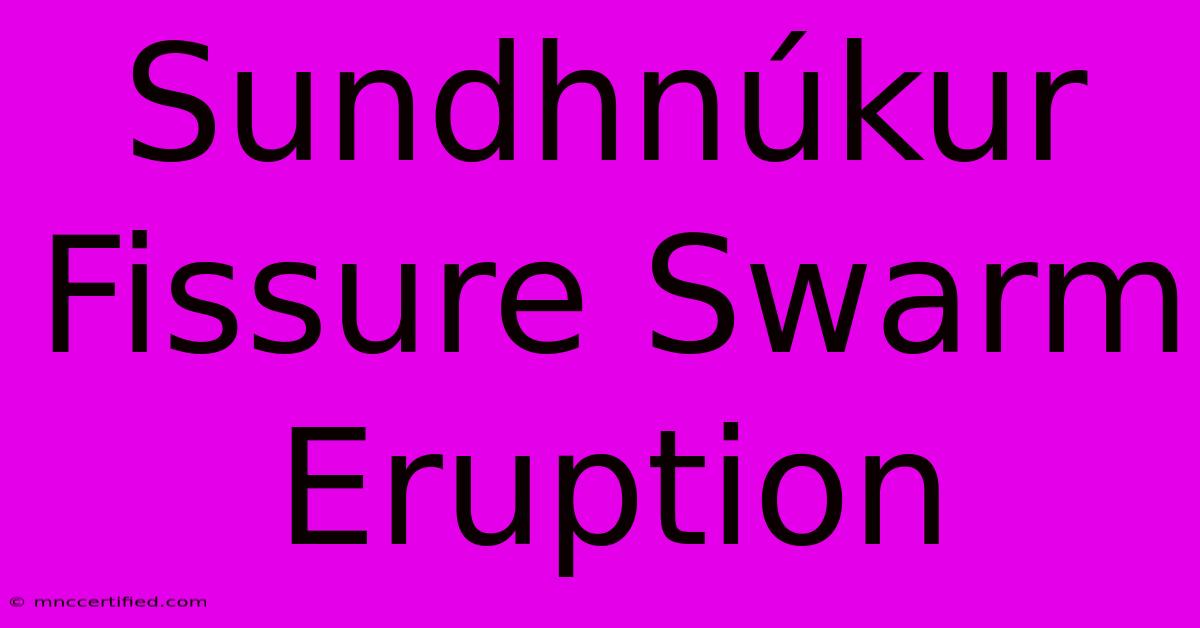Sundhnúkur Fissure Swarm Eruption

Table of Contents
Sundhnúkur Fissure Swarm Eruption: Iceland's Recent Volcanic Activity
Iceland, the land of fire and ice, recently experienced a significant volcanic event: the Sundhnúkur fissure swarm eruption. This eruption, while not as dramatic as some previous Icelandic eruptions, presents a fascinating case study in volcanic activity and offers valuable insights into monitoring and understanding these powerful natural phenomena. This article delves into the specifics of the Sundhnúkur eruption, exploring its geological context, impact, and the scientific lessons learned.
Understanding the Sundhnúkur Fissure Swarm
The Sundhnúkur fissure swarm eruption, located in the Reykjanes Peninsula, is characterized by its effusive nature. Unlike explosive eruptions that violently eject ash and pyroclastic flows, effusive eruptions involve the relatively gentle outpouring of lava. This is largely due to the low viscosity (thickness) of the basaltic magma involved. The eruption wasn't a single point source, but rather a series of fissures – cracks in the Earth's surface – from which lava flowed. This is typical of many Icelandic eruptions, which are often associated with these fissure swarms.
Geological Context and Significance
The Reykjanes Peninsula is a highly volcanically active region, sitting atop the Mid-Atlantic Ridge, a divergent tectonic plate boundary. The constant movement and interaction of the North American and Eurasian plates create the geological conditions necessary for magma generation and eruption. The Sundhnúkur eruption is part of a recent period of increased volcanic activity in the region, highlighting the dynamic nature of this geological hotspot. Understanding the timing and mechanisms of these eruptions is crucial for improving volcanic hazard assessment and mitigation strategies. Researchers are actively studying the Sundhnúkur eruption to refine these models and improve predictive capabilities.
The Eruption's Impact
While the lava flows from the Sundhnúkur eruption were relatively slow-moving, they still posed significant risks. The primary impact was the destruction of infrastructure and land in the immediate vicinity. Lava flows can cover roads, destroy buildings, and disrupt vital services. However, due to effective monitoring and evacuation procedures, no casualties were reported. The eruption also released volcanic gases, which can be harmful to human health and the environment. Scientists carefully monitored gas emissions to assess the potential impact on air quality and to inform any necessary public health advisories.
Scientific Monitoring and Lessons Learned
The Sundhnúkur fissure swarm eruption provided a valuable opportunity for scientists to test and refine their monitoring techniques. Advanced seismic monitoring, GPS measurements, and satellite imagery played critical roles in tracking the eruption's progression and predicting its behavior. This data is invaluable in developing more accurate eruption forecasting models. The eruption underscored the importance of robust monitoring infrastructure and international collaboration in studying and mitigating volcanic hazards.
Future Research and Implications
The data collected during the Sundhnúkur eruption will be used for years to come, helping researchers improve their understanding of volcanic processes and refine risk assessment tools. This research has significant implications for improving volcanic hazard management not only in Iceland but also in other volcanically active regions around the world. The insights gained will contribute to more effective emergency response planning and ultimately, help protect communities living in the shadow of volcanoes.
Conclusion: A Dynamic Geological Event
The Sundhnúkur fissure swarm eruption serves as a powerful reminder of the dynamic geological forces shaping our planet. While the eruption itself was not exceptionally large or destructive, its significance lies in the scientific insights it provides and the opportunity it offers to refine our understanding of volcanic processes and improve hazard mitigation strategies. Continued monitoring and research are crucial for ensuring the safety and well-being of communities living in volcanically active areas. The lessons learned from the Sundhnúkur eruption will contribute to a safer future for those living alongside these powerful forces of nature.

Thank you for visiting our website wich cover about Sundhnúkur Fissure Swarm Eruption. We hope the information provided has been useful to you. Feel free to contact us if you have any questions or need further assistance. See you next time and dont miss to bookmark.
Featured Posts
-
21 01 An Hour Is How Much A Year
Nov 21, 2024
-
Where Is Kemi Badenoch Alex Burghart Pmqs Role
Nov 21, 2024
-
22 15 An Hour Is How Much A Year
Nov 21, 2024
-
Stalker 2 Review Par For The Zone
Nov 21, 2024
-
Pulsechain Price Prediction 2025
Nov 21, 2024